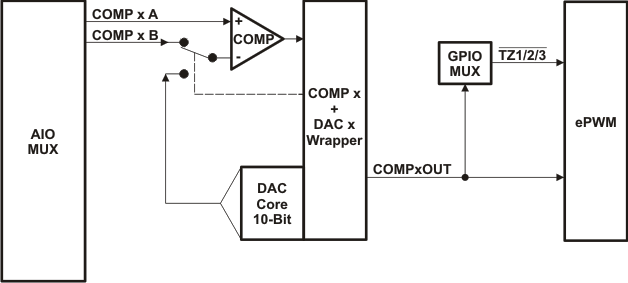SPRSP25A June 2018 – July 2018 TMS320F28035-EP
PRODUCTION DATA.
- 1Device Overview
- 2Revision History
- 3Terminal Configuration and Functions
-
4Specifications
- 4.1 Absolute Maximum Ratings
- 4.2 ESD Ratings
- 4.3 Power-On Hours (POH) Limits
- 4.4 Recommended Operating Conditions
- 4.5 Power Consumption Summary
- 4.6 Electrical Characteristics
- 4.7 Thermal Resistance Characteristics
- 4.8 Thermal Design Considerations
- 4.9 Emulator Connection Without Signal Buffering for the MCU
- 4.10 Parameter Information
- 4.11 Test Load Circuit
- 4.12 Power Sequencing
- 4.13 Clock Specifications
- 4.14 Flash Timing
-
5Detailed Description
- 5.1
Overview
- 5.1.1 CPU
- 5.1.2 Control Law Accelerator (CLA)
- 5.1.3 Memory Bus (Harvard Bus Architecture)
- 5.1.4 Peripheral Bus
- 5.1.5 Real-Time JTAG and Analysis
- 5.1.6 Flash
- 5.1.7 M0, M1 SARAMs
- 5.1.8 L0 SARAM, and L1, L2, and L3 DPSARAMs
- 5.1.9 Boot ROM
- 5.1.10 Security
- 5.1.11 Peripheral Interrupt Expansion (PIE) Block
- 5.1.12 External Interrupts (XINT1–XINT3)
- 5.1.13 Internal Zero Pin Oscillators, Oscillator, and PLL
- 5.1.14 Watchdog
- 5.1.15 Peripheral Clocking
- 5.1.16 Low-power Modes
- 5.1.17 Peripheral Frames 0, 1, 2, 3 (PFn)
- 5.1.18 General-Purpose Input/Output (GPIO) Multiplexer
- 5.1.19 32-Bit CPU-Timers (0, 1, 2)
- 5.1.20 Control Peripherals
- 5.1.21 Serial Port Peripherals
- 5.2 Memory Maps
- 5.3 Register Maps
- 5.4 Device Emulation Registers
- 5.5 VREG/BOR/POR
- 5.6 System Control
- 5.7 Low-Power Modes Block
- 5.8 Interrupts
- 5.9
Peripherals
- 5.9.1 Control Law Accelerator (CLA) Overview
- 5.9.2 Analog Block
- 5.9.3 Detailed Descriptions
- 5.9.4 Serial Peripheral Interface (SPI) Module
- 5.9.5 Serial Communications Interface (SCI) Module
- 5.9.6 Local Interconnect Network (LIN)
- 5.9.7 Enhanced Controller Area Network (eCAN) Module
- 5.9.8 Inter-Integrated Circuit (I2C)
- 5.9.9 Enhanced PWM Modules (ePWM1/2/3/4/5/6/7)
- 5.9.10 High-Resolution PWM (HRPWM)
- 5.9.11 Enhanced Capture Module (eCAP1)
- 5.9.12 High-Resolution Capture (HRCAP) Module
- 5.9.13 Enhanced Quadrature Encoder Pulse (eQEP)
- 5.9.14 JTAG Port
- 5.9.15 General-Purpose Input/Output (GPIO) MUX
- 5.1
Overview
- 6Applications, Implementation, and Layout
- 7Device and Documentation Support
- 8Mechanical, Packaging, and Orderable Information
Package Options
Mechanical Data (Package|Pins)
- PN|80
Thermal pad, mechanical data (Package|Pins)
Orderable Information
5.9.2.3 Comparator Block
Figure 5-23 shows the interaction of the Comparator modules with the rest of the system.
 Figure 5-23 Comparator Block Diagram
Figure 5-23 Comparator Block Diagram Table 5-31 Comparator Control Registers
| REGISTER NAME | COMP1 ADDRESS | COMP2 ADDRESS | COMP3 ADDRESS | SIZE
(x16) |
EALLOW
PROTECTED |
DESCRIPTION |
|---|---|---|---|---|---|---|
| COMPCTL | 0x6400 | 0x6420 | 0x6440 | 1 | Yes | Comparator Control Register |
| COMPSTS | 0x6402 | 0x6422 | 0x6442 | 1 | No | Comparator Status Register |
| DACCTL | 0x6404 | 0x6424 | 0x6444 | 1 | Yes | DAC Control Register |
| DACVAL | 0x6406 | 0x6426 | 0x6446 | 1 | No | DAC Value Register |
| RAMPMAXREF_
ACTIVE |
0x6408 | 0x6428 | 0x6448 | 1 | No | Ramp Generator Maximum Reference (Active) Register |
| RAMPMAXREF_
SHDW |
0x640A | 0x642A | 0x644A | 1 | No | Ramp Generator Maximum Reference (Shadow) Register |
| RAMPDECVAL_
ACTIVE |
0x640C | 0x642C | 0x644C | 1 | No | Ramp Generator Decrement Value (Active) Register |
| RAMPDECVAL_
SHDW |
0x640E | 0x642E | 0x644E | 1 | No | Ramp Generator Decrement Value (Shadow) Register |
| RAMPSTS | 0x6410 | 0x6430 | 0x6450 | 1 | No | Ramp Generator Status Register |